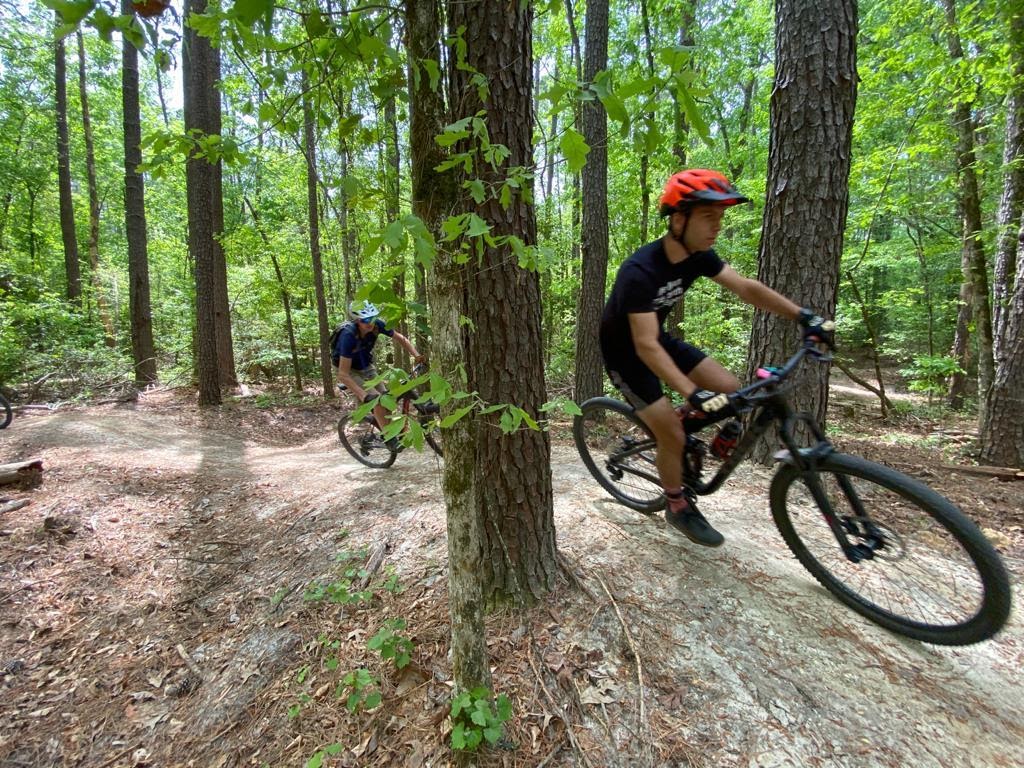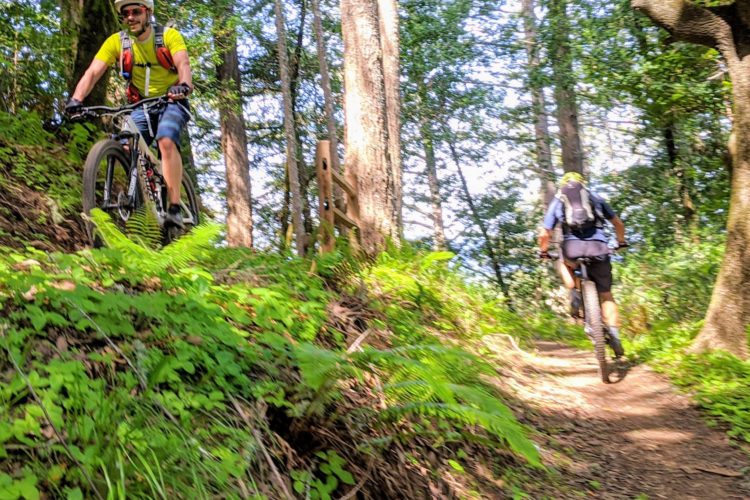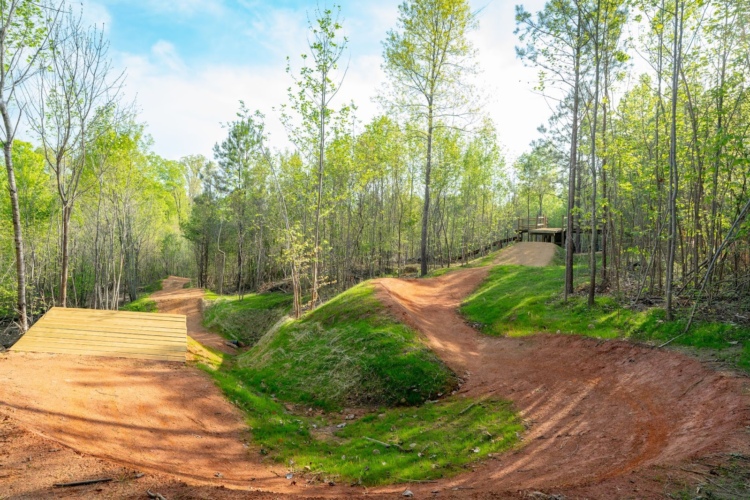
If you’re like me, you take your local trails for granted. I have at least a half dozen trails within 20 minutes’ drive time of my house and ride most of them 2-3 times a week on average. Not everyone is that fortunate.
Though it has a very diverse mountain bike community and a local NICA team, Onslow County, North Carolina (home of Marine Corps base Camp LeJeune) had few options for riders when it came to MTB trails. There was a 2-mile trail in downtown Jacksonville and a longer trail on base in Camp LeJeune, provided one had permission to access the base. Otherwise, residents had to drive nearly two hours away to access additional trails.
Then came the Big Branch Bike Park, which opened in the summer of 2021. The brainchild of a county-organized committee, the grant-funded trail system was built on the grounds of an industrial park owned by the county with the help of two North Carolina-based trail-building companies. This is the story of how the trails came to be and how they have benefited a small coastal community.
The idea for a new trail system is born

In 2019, the county manager for Onslow County created the Idea Incubator Committee, comprised of county officials and members of the local community, to come up with ideas for how the county could improve serving its residents. One of its members, Eric Walden, a building inspector for Onslow County and avid mountain biker, proposed building new mountain bike trails. After floating several other ideas, the rest of the committee members agreed with Walden’s proposal. The committee then pitched the idea to the county commission, who unanimously approved it in a public meeting. Then the hunt for land suitable for building new trails began.
After looking at several possible sites, the county decided the best terrain for trails was located within an industrial park it owned. The land was not otherwise suitable for development, so outdoor recreation would be a perfect use for it. Site in hand, the county then pursued funding for the trails and sought out qualified trail builders for the project.
A government grant helps brings the vision of new trails to life
Onslow County is not flush with extra revenue for trail building. To create the Big Branch Bike Park, it needed to secure outside funds, so the county applied for a grant from the Recreational Trails Program (RTP). According to the North Carolina Trails’ website, RTP is “designed to help states provide and maintain recreational trails for both motorized and non-motorized recreational trail use. The program is administered by the U.S. Department of Transportation’s Federal Highway Administration.”
The county applied for and received a $249,200 RTP grant. Walden then reached out to trail builders in western North Carolina. Only one trail builder showed any interest in building new trails near the coast: Craig Brickser of Community Trail Design in Charlotte, North Carolina. Brickser holds a master’s degree in urban planning with a specialization in land use planning from Florida State University. He has nearly a decade of experience designing, planning, and constructing natural surface trail systems for non-profit organizations such as the International Mountain Bicycling Association (IMBA) and the Evergreen Mountain Bike Alliance, as well as local governments across the U.S.
Craig Brickser of Community Trail Design was the master designer of the Big Branch Bike Park Trails.
Brickser admits he was a bit skeptical about building a trail system so close to the Carolina Coast. “From a professional trail design standpoint, the coastal plain is not a hotbed of trail opportunity.” Nevertheless, he agreed to do a feasibility study for the county in March of 2020. When he saw the proposed site, he was pleasantly surprised. “It was a big prominent bluff with a canopy of beautiful, mature hardwood trees and loamy soil reminiscent of a piedmont or foothills environment. I realized there was something I could work with.”
The proposed site is a topographic anomaly in the area. “The area is coastal plain. It is typically very flat and has a sandy soil composition.” However, the site was in an area where the tributaries and delta of the New River in North Carolina meets the Atlantic Ocean. Its bluffs were undeveloped because they had no agricultural value, and agriculture is the primary industry in that area.
For Brickser, the biggest question he had was whether the soil of the bluff would hold a bench cut. “Thankfully, we had some great examples of the soil’s stability on display from old fire breaks. There was a 5-foot fire break cut around the perimeter of the bluffs that was half a century old. It was all the evidence I needed. We were going to bench cut trail in the coastal plain.”
Once he saw the land, Brickser agreed to take on the project and began the planning process

Stakeholders survey the land and discuss their vision for the trails.
Brickser attended a couple of stakeholder meetings with county officials and members of the local mountain bike club. Together, they established goals and visions for the trails. The county’s main objectives were to have a certain amount of mileage, and the space to hold events. The county had a strong desire to increase access to trails and increase tourism to the area.
Additionally, some of the stakeholders wanted to see the land where the proposed trails would be built to be preserved. As Brickser described it, “the property was an industrial park with paved roads and cul-de-sacs running through it. There were for-sale signs on some parts of the property. I think some of the stakeholders wanted to see it used for other purposes. Bringing me in confirmed the land had recreational value.”
One of those stakeholders was Tony Padgett, the director of county operations and a third generation native of Onslow County. Brickser calls him one of the unsung heros of the project. “His family had logged the land. He knew the soils, the trees, and the wetlands, and helped us understand how the natural systems of the land functions. He was not a mountain biker, but he had a deep appreciation of the outdoors, and a love for his community. He wanted to see people get out into those woods. His motto was “keep it natural”
With a plan in place, trail building began in early 2021

Brickser’s idea for the project was to create bench-cut style trails that followed the contours of the bluffs located on the property. “I wanted to create a foothills-style experience that gave riders the feeling of being elevated.” The final plan for the trails was 4.6 miles of bluff trail designed for intermediate riders, and a 1.6-mile upland trail for beginner riders.

The land itself is an average of 12-15ft above sea level, so designing trails that gave the illusion of higher elevation was tricky. “It was an exercise in recycling gravity to give flow to the trails.” Brickser also needed to follow the contours of the land strictly because he was not sure how the trail would hold up.
The soil composition threw a wrench into Brickser’s initial plans for the trails

As work began, Brickser ran into an issue with the soil composition itself. He thought there was well-drained sandy loam soil throughout the property that would allow him to add some upland mileage throughout a flat plateau of upland pines. However, when he visited the property after a sustained rainfall, he realized that was not the case.

Brickser discovered there was an iron hardpan layer a few feet below the surface. Padgett dug some test holes to show Brickser and they almost immediately filled with water. Brickser was shocked to see how shallow the water table was. “It doesn’t allow water to percolate down into the ground, so the water either sits on the surface or runs laterally until it breaks through the surface as a seep spring.”
He had to go back to the drawing board. The best bet for the trail system was to maximize the amount of trail cut across the slopes of the bluffs, where Brickser knew he could achieve positive drainage.
After discovering the soil issues, Brickser brings in Trail Dynamics to help build the trails
To help create trails in such a tricky environment, Brickser brought on Ed Sutton and his Trail Dynamics crew as subcontractors. “I had known Ed for about 10 years. I met him when I was in school in Tallahassee and worked for him on a couple of projects after I graduated. I knew Ed had done the trails at Munson Hills in Tallahassee, and I didn’t know anyone else who had his experience working on trails in coastal plains. I did not want to bring in someone who had never worked in this kind of environment before.” Brickser also had to create several miles of trail in a short period of time so he needed additional help.
Like Brickser, Sutton was skeptical of the project site at first. “When I and my crew arrived at the job site in Onslow County, I was thinking, ‘boy, this place is flat.’ Of course, that was to be expected since we were only 15 miles from the North Carolina Coast. Brickser had sent me pictures of majestic live oaks and rolling terrain, but all I could see when I looked around was a level pine forest.” However, when Brickser walked Sutton through the property, he saw the bluffs with rolling terrain that was ripe for building mountain bike trails.
In addition, Sutton knew the project would be successful after meeting the stakeholders who had been pushing for it. “The first night in town they treated us to a seafood fiesta. Padgett was on the grill and keeping us all entertained with shrimp boat stories. We were also warmly welcomed by Benjamin Warren (the Assistant County Manager of Onslow County), whose determination and fundraising skills had pushed the project through the county approval process. Finally, we met Eric Walden, a relatively new employee of Onslow County, whose idea for the project had helped get the ball rolling two years earlier.”
As for the trail design itself, Sutton gives a lot of credit to Brickser. “Trail design is often overlooked or taken for granted, but all trail builders know the importance of having a solid design. Brickser had really put down a creative flag line that made the best use of the available terrain. By surfing through the high bluffs along the river, Brickser gave me and my crew a blueprint for an amazing trail.”
Sutton credits the local mountain bike community for its help in completing the project

The stakeholders wanted two distinctly different trails. According to Sutton, the shorter trail “was meant to be bi-directional and beginner-friendly, with easy grades, wide rhythm, and enough room for passing. In contrast, the longer trail “would be narrower, surf the bluffs, and have more elevation change.”
To ensure he was on the right path, Sutton had daily contact with the stakeholders in Onslow County. “We constantly ride and test our trails as we build them, and I invited them to do the same. The first week of any new project, it’s important to make sure everyone is on the same page and sharing a similar vision.”
Sutton also involved local riders in the build process. “One Saturday, the local bike club and NICA team showed up to burn in the first loop. Before Big Branch, the NICA team had to travel out of town for races. Once finished, Big Branch would be their go-to trail for races and training. The fatigue of four weeks of trail building faded away the moment I saw them riding onto the trail with big smiles and whooping at the top of their lungs.”
Additionally, the local cycling club, Downeast Cyclists, gave Sutton and his crew a feeling of community that helped sustain them throughout the time they worked on the project. “When projects take you away from home for days, weeks, and even months at a time, it’s connections with the local mountain bike community that keeps you going. We instantly connected with the people at Onslow County, including the local club. With Big Branch’s proximity to Camp LeJeune, a large part of the club is comprised of active or retired Marines and their families. As soon as we got started, these members adopted the trails as their own and started coming out on weekends to volunteer and pack in the new trails.”
While Bricker and Sutton worked on the trails, the county built the infrastructure for them. According to Walden, “the parking lot accommodates up to 50 vehicles. We have a small restroom facility with two unisex bathrooms, two changing rooms, and a storage closet for trail maintenance tools and signage. There are also wide shoulders on the road leading to the park and the park is located adjacent to county government buildings, so there is space for several hundred vehicles to park if necessary.”
Since opening, the Big Branch Bike Park has benefited the local community as well as the Marines stationed at Camp LeJeune

Riders of all ages and skill levels have been enjoying Big Branch Bike Park since it opened in the summer of 2021.
For Warren, the Big Branch Bike Park has been a huge win for the community. “While we do not have statistics on the number of actual riders, we have been counting an average of 250 cars a week at the trailhead since it opened.”
Warren has also seen the trails used regularly by the Marines stationed at Camp LeJeune. “We have had some great feedback from them. I have seen Marine Corps Community Services come out to the trails frequently with their fleet of rental bikes. Units will come out to the trails for PT and then ride bikes afterwards.”
The Big Branch Bike Park also hosted its first race the weekend after Thanksgiving for the Coastal Carolina Off-Road Series. Seventy-nine riders raced in the event. With the facilities being designed to host large events, Warren hopes to see a NICA race held there soon.
Major James O’Brien, who is currently stationed at Camp LeJeune, had high praise for the new trails. “I think it’s great. There’s now more than one place riders can go in this area. It’s also great for beginner riders because it doesn’t have a lot of technical features like the trails on base in Camp LeJeune, which are very rooty.”
With the success of Phase I, Onslow County will be creating even more trails in the future

There’s plenty of room for more trails and Onslow County hopes to add some soon.
Brickser hopes work will start soon on Phase II of the Big Branch Bike Park “In Phase II, I’m going to push the boundaries a little more. I still have some limitations because I can’t do a lot of terraforming or create a lot of berms, but I am going to line the trail a little more aggressively with the native soil.”
Brickser plans to compensate for the soil’s weaknesses by adding features like bridges and culverts, as well as importing some rock and clay to armor and enhance the surface for speed and flow. He wants to make the new addition appealing to advanced riders since the first phase was geared toward beginner and intermediate riders. When finished, Brickser hopes it will add another 5.5 miles of trail. The county is also considering adding a skills park as part of Phase II but nothing definite has been decided.
The Big Branch Bike Park created access in a community that was sorely lacking trails

For Brickser, building trails in Onslow County was more than just another job. “This is an equity issue. People having access to trails within their own community. The area is a trail desert and we filled in a huge gap with these trails.”
Additionally, Brickser believes the trails will put Onslow County on the map as an outdoor recreation area. “Jacksonville is on the way to the beach and the trails are going to turn it into a multi-recreational area.”
Learn about Phase 2 of Big Branch’s trail development, here.






















0 Comments